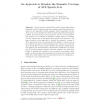Free Online Productivity Tools
i2Speak
i2Symbol
i2OCR
iTex2Img
iWeb2Print
iWeb2Shot
i2Type
iPdf2Split
iPdf2Merge
i2Bopomofo
i2Arabic
i2Style
i2Image
i2PDF
iLatex2Rtf
Sci2ools
ER
2005
Springer
2005
Springer
An Approach to Broaden the Semantic Coverage of ACL Speech Acts
Current speech-act based ACLs specify domain-independent information about communication and relegate domain-dependent information to an unspecified content language. This is reasonable, but the ACLs cover only a small fraction of the domain-independent information possible. As a key element of modern ACLs, the set of communicative acts needs to be as complete as possible to enable agents to communicate the widest range of information with agreed-upon semantics. This paper describes a new approach to broaden the semantic coverage of ACL speech acts. It provides agents with the ability to express more of the possible meanings in human languages and yields a more powerful ACL. Specifically, we first compare Austin’s and Searle’s classifications, and Ballmer and Brennenstuhl’s comprehensive classification of speech acts. The main meaning categories and their semantics are given next. Finally, a multifaceted evaluation of our approach is presented, which points out that the appr...
| Added | 27 Jun 2010 |
| Updated | 27 Jun 2010 |
| Type | Conference |
| Year | 2005 |
| Where | ER |
| Authors | Hong Jiang, Michael N. Huhns |
Comments (0)

